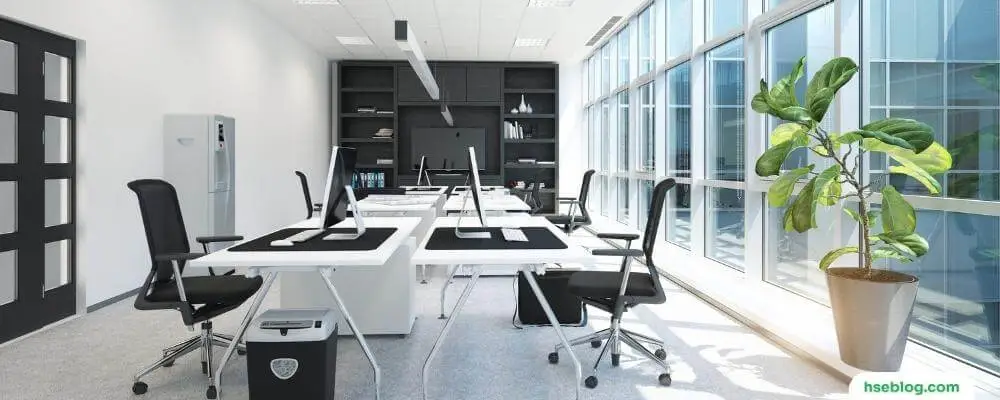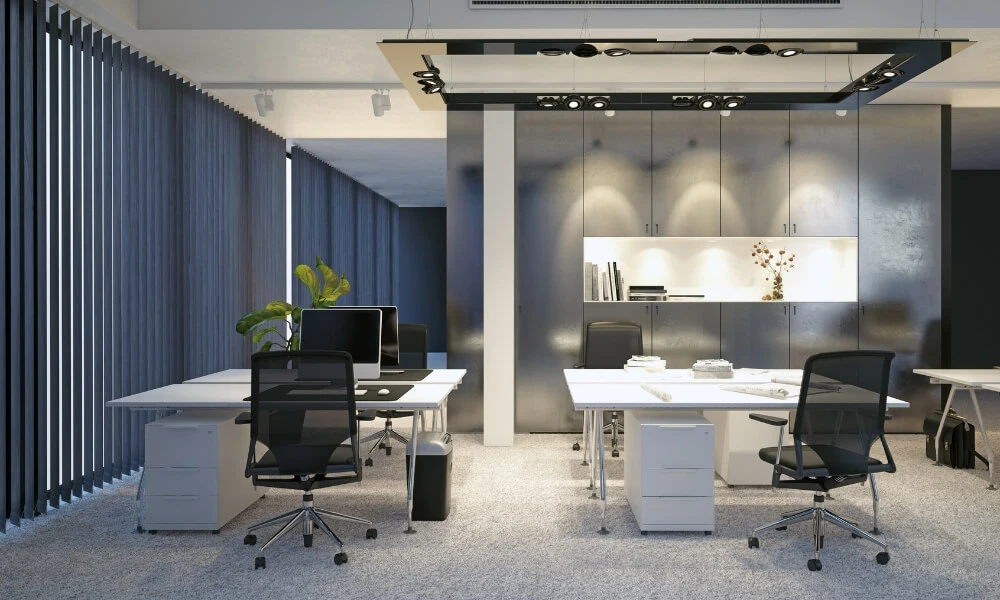In today’s fast-paced world, the physical work environment plays a crucial role in employee productivity, health, and overall job satisfaction. One aspect of the work environment that’s often overlooked but holds significant importance is workplace lighting. Adequate lighting is not just a necessity but a critical component that can impact multiple facets of work life, ranging from task efficiency to employees’ physical and psychological well-being.
Lighting in the workplace is far more than just being able to see clearly. It goes beyond illumination, permeating various aspects of the work experience. It is an integral part of workplace ergonomics – the science of optimizing the work environment for the comfort and productivity of the employee. It can greatly affect concentration, mood, fatigue levels, and even safety in the workspace.
The significance of workplace lighting has been recognized for decades. In fact, as far back as the 1920s and 1930s, the Hawthorne Studies, some of the first investigations into workplace environments, found that lighting adjustments could impact worker productivity. While the studies had some flaws, the idea that environmental factors like lighting could affect work output was revolutionary at the time and continues to inform office design today.
It’s important to remember that adequate lighting doesn’t necessarily mean brighter lighting. Instead, it’s about having the right type and lighting level where and when needed. This balance contributes to a better working environment, enhancing employee morale, reducing strain, and improving productivity.
In the forthcoming sections, we delve deeper into the psychology of light, its influence on health and safety, its impact on productivity, and more. By understanding these elements, businesses can make informed decisions about their workplace lighting, contributing to a better work environment for everyone involved.

The Psychology of Light
Light profoundly impacts the human psyche, influencing our mood, productivity, and well-being. This is due to our intrinsic biological responses and psychological associations with lighting conditions.
How Light Affects Mood, Productivity, and Well-being
Research has shown that lighting conditions can significantly affect a person’s mood and cognitive performance. Bright light, especially natural light, has been associated with positivity, improved mood, and increased energy. In contrast, dim light can make tasks seem more difficult and can lead to feelings of sadness or even depression.
The link between light and productivity is also well-established. Studies indicate that people often perform better under conditions of higher illumination. Optimal lighting can enhance mental acuity, reduce fatigue, and decrease the likelihood of making errors. Furthermore, the right lighting can also positively affect circadian rhythms, sleep, and overall well-being.
Natural vs. Artificial Light
There’s a distinct difference in how natural and artificial light affects workers. Exposure to natural light has numerous benefits. It helps regulate our body’s internal biological clock, or circadian rhythm, promoting better sleep and overall health. Natural light during the day can increase alertness and mood, reducing the likelihood of afternoon slumps.
On the other hand, artificial light, particularly harsh fluorescent lighting, can lead to problems such as eyestrain, headaches, fatigue, stress, and anxiety. It’s crucial to note that not all artificial light is harmful. The key is choosing the right artificial lighting that closely mimics natural light. For example, LED lights that mimic natural light have been shown to reduce the negative effects often associated with artificial lighting.
A mix of natural and artificial light can provide a balanced solution in environments where relying solely on natural light is impossible. By understanding how different types of light affect workers, businesses can create better-lit environments that promote health, well-being, and productivity.
The Role of Lighting in Health and Safety
Workplace lighting directly impacts employee health and safety. Poor or inadequate lighting can contribute to various health issues and increase the likelihood of workplace accidents.
Health Issues Associated with Poor Lighting
Poor lighting in the workplace can lead to several health issues. One common problem is visual discomfort and eyestrain. Inadequate lighting makes it difficult for the eyes to focus, which strains the eye muscles leading to discomfort, blurred vision, dry eyes, and headaches. Over time, constant eyestrain can lead to more serious problems like vision impairment.
In addition, poor lighting conditions can cause fatigue and negatively impact mental health. Dim lighting can increase melatonin production, the hormone that regulates sleep, making workers feel tired and less alert. Furthermore, prolonged exposure to dim or harsh artificial lighting can contribute to stress, anxiety, and mood disorders.
The Role of Lighting in Preventing Workplace Accidents
Workplace safety is another crucial aspect influenced by lighting. Insufficient or poorly placed lighting can lead to accidents such as slips, trips, and falls. These are some of the most common workplace incidents, especially in physical or manual work environments. Good lighting ensures that all areas, including corners, stairs, and entrances, are adequately lit, minimizing the risk of accidents.
Moreover, appropriate lighting is essential for workers who operate machinery or vehicles. For them, visibility is crucial to maintain precision and safety. Any inadequacy in lighting can result in severe accidents, causing harm to the employee and potentially damaging equipment or goods.
By recognizing the role of lighting in health and safety, businesses can implement better lighting solutions. This contributes to a healthier work environment and reduces the risks associated with workplace accidents, promoting a culture of safety.

The Impact of Lighting on Productivity
Numerous research and real-world examples support the correlation between adequate lighting and productivity. The effect of lighting on performance is not just anecdotal; it is a well-documented fact that has been consistently recognized in various studies and investigations.
Correlation between Adequate Lighting and Productivity
Several studies have established a direct link between lighting conditions and productivity. For instance, a study by the American Society of Interior Designers found that 68% of employees complain about the lighting situation in their offices, negatively impacting their productivity.
Research by the Lighting Research Center in New York suggests that exposure to natural light significantly improves productivity and performance. The researchers found that tasks performed under daylight conditions were completed 15% faster than those performed under artificial lighting.
Another study conducted by Northwestern Medicine and the University of Illinois at Urbana-Champaign revealed that workers in offices with windows, which provide abundant daylight and views of the outdoors, slept 46 minutes more per night. They also reported better quality of life and physical outcomes, including better productivity, than those with no natural light exposure in the workplace.
Real-life Examples/Case Studies
Several companies have seen firsthand the benefits of investing in better workplace lighting. For instance, Lockheed Martin, a renowned American aerospace, defense, and security company, saved an estimated $500,000 per year in productivity gains after implementing a new lighting system.
Another example is the Sacramento Municipal Utility District’s Customer Service Center, which reported a 6% increase in data entry speed after replacing dim lighting with a well-designed lighting system.
These studies and examples provide compelling evidence that investing in adequate lighting is not a luxury but necessary for businesses aiming to improve productivity. By understanding the direct impact of lighting on productivity, businesses can make strategic decisions regarding their workplace environments, ultimately fostering a more productive and satisfied workforce.
The Influence of Lighting on Workplace Aesthetics
Workplace aesthetics, or a workspace’s visual appeal and comfort, is an often-underestimated factor in employee satisfaction and productivity. Lighting plays a significant role in shaping workplace aesthetics, influencing the workspace’s overall look and feel.
How Lighting Contributes to the Overall Look and Feel of the Workplace
Lighting is one of the primary elements shaping the perception of a workspace. It can make a space appear open and airy or closed and cozy. A well-lit office often appears more inviting, encouraging employees to be more engaged and creative.
On the other hand, poor lighting can make a workspace dull and gloomy, leading to a less appealing and less inspiring work environment. Different types of lighting can also affect how color is perceived in the workspace. For instance, natural light can bring out the true colors of the interior décor, whereas artificial light may alter color perception.
The Role of Lighting in Creating a Conducive and Comfortable Environment
Creating a conducive and comfortable work environment is not just about aesthetics; it also greatly influences how employees feel and perform in the workspace. Lighting plays a crucial role in this regard.
Good lighting reduces eye strain and the risk of headaches, making it easier for employees to focus on their tasks. Furthermore, access to natural light has been linked to increased satisfaction, productivity, and well-being.
Adjustable lighting solutions also allow employees to modify their lighting conditions according to their needs or tasks, making the workspace more flexible and personalized. For example, task lighting can be used to focus on specific work areas, reducing the need for overall brightness and thus saving energy.

Modern Lighting Solutions for the Workplace
As technology advances, modern lighting solutions have emerged, offering improved efficiency, flexibility, and control over workplace lighting. These solutions include LEDs, smart lights, and adjustable lighting options.
LEDs (Light-Emitting Diodes)
LED lighting has gained popularity in recent years due to its numerous advantages. LEDs are energy-efficient and can significantly reduce electricity costs compared to traditional incandescent or fluorescent lighting. They have a longer lifespan, resulting in reduced maintenance and replacement costs.
Furthermore, LEDs offer a range of color temperatures, allowing businesses to choose lighting that closely mimics natural daylight. This can improve employee mood, well-being, and productivity. LEDs are also compatible with dimming systems, enabling businesses to adjust lighting levels according to specific tasks or preferences.
One drawback of LED lighting is the initial cost, which can be higher than traditional lighting options. However, the long-term energy and maintenance savings typically offset the initial investment.
Smart Lights
Smart lighting systems integrate technology to provide advanced control and automation. These systems use sensors, timers, and wireless connectivity to manage lighting based on occupancy, daylight levels, or predefined schedules. Smart lights can be controlled remotely via smartphone apps or integrated with building management systems.
The benefits of smart lights include energy savings through optimized lighting usage, increased flexibility, and improved customization. For example, smart lights can automatically adjust brightness and color temperature throughout the day to align with natural light patterns. This can help regulate circadian rhythms and enhance employee well-being.
However, implementing smart lighting systems may require upfront hardware, installation, and programming investments. Additionally, businesses must ensure proper network security to protect against cyber threats.
Adjustable Lighting
Adjustable lighting solutions can modify lighting levels, color temperature, and direction to suit individual preferences or specific tasks. This can be achieved through dimming controls, adjustable fixtures, or movable task lights.
The benefits of adjustable lighting include increased comfort, reduced eye strain, and improved productivity. Employees can customize lighting according to their needs, creating a personalized and tailored workspace. Adjustable lighting also offers flexibility in multi-use spaces with different lighting requirements.
The potential drawback of adjustable lighting is the need for proper training and education to ensure employees understand how to optimize lighting settings. Additionally, businesses should consider the cost and maintenance of adjustable lighting systems.
Tips for Improving Workplace Lighting
Improving workplace lighting is essential for creating a productive and comfortable environment. Here are some practical tips and suggestions to enhance the lighting in your workplace:
- Conduct a lighting audit: Begin by assessing your current lighting situation. Identify areas with inadequate lighting, flickering bulbs, or excessive glare. This audit will help you understand the specific lighting needs of different areas in your workplace.
- Maximize natural light: Make the most of natural light sources whenever possible. Position workstations near windows or skylights to maximize natural daylight. Remove any obstructions that may block the flow of natural light into the workspace.
- Use layered lighting: Implement a layered approach by combining ambient, task, and accent lighting. Ambient lighting provides overall illumination, task lighting focuses on specific work areas, and accent lighting adds visual interest and highlights key features.
- Choose the right color temperature: Consider the color temperature of your lighting. Cooler color temperatures (around 5000K) promote alertness and focus, while warmer temperatures (around 2700K to 3000K) create a more relaxed and comfortable atmosphere. Adjust lighting color temperatures based on the needs of each workspace.
- Reduce glare: Minimize glare by positioning light sources away from reflective surfaces and using fixtures with glare-reducing features. Install window coverings or use diffusers to soften the intensity of natural light when glare becomes an issue.
- Opt for adjustable lighting: Incorporate adjustable lighting options, such as dimmers or task lights. This lets employees personalize their lighting levels to match their preferences and tasks.
- Ensure uniform lighting distribution: Aim for even lighting distribution throughout the workspace. Avoid areas of excessive brightness contrasted with dark spots. Use lighting fixtures that provide uniform illumination to prevent eye strain and discomfort.
- Maintain lighting fixtures: Regularly clean and maintain lighting fixtures to ensure they operate at their full potential. Replace burnt-out bulbs promptly and consider upgrading to energy-efficient options like LEDs to reduce energy consumption and maintenance requirements.
- Consider lighting control systems: Implement lighting control systems, such as occupancy sensors or timers, to optimize energy usage. These systems automatically adjust lighting based on occupancy or time of day, reducing energy waste.
- Seek employee feedback: Involve employees by seeking their input on lighting preferences and comfort levels. Encourage them to provide feedback on any issues or areas that need improvement.

Balancing Natural and Artificial Light in the Workplace
Achieving a balance between natural and artificial light is crucial for optimal lighting in the workplace. Here are a few strategies to achieve this balance:
- Position workstations to take advantage of natural light while avoiding glare or discomfort.
- Use window coverings or adjustable blinds to regulate the amount of natural light entering the workspace.
- Integrate adjustable artificial lighting to supplement natural light and provide consistent daily illumination.
- Install light sensors that automatically adjust artificial lighting levels based on the availability of natural light.
- Consider the placement of artificial lighting fixtures to prevent casting shadows or creating harsh contrasts when natural light is present.
By implementing these tips and finding the right balance between natural and artificial light, you can create a well-lit workspace that promotes productivity, comfort, and employee well-being.
Conclusion
Adequate lighting in the workplace plays a crucial role in employee well-being, productivity, and overall job satisfaction. It goes beyond mere illumination, influencing factors such as mood, health, safety, and aesthetics.
Proper lighting significantly impacts employee mood, productivity, and well-being. Studies have shown that exposure to natural light improves mood, cognitive performance, and overall satisfaction. Conversely, poor lighting can lead to visual discomfort, eyestrain, fatigue, and decreased productivity.
Regarding health and safety, inadequate lighting can contribute to various health issues, such as eye strain and headaches. Additionally, it can increase the risk of workplace accidents, especially in poorly lit areas or when working with machinery.
Lighting is also vital in creating a conducive and comfortable work environment. It contributes to workplace aesthetics, shaping the look and feel of the space. By balancing natural and artificial light, businesses can create a visually appealing and comfortable atmosphere that enhances employee engagement and satisfaction.
Investing in modern lighting solutions such as LEDs, smart lights, and adjustable lighting can further improve the workplace environment. These solutions offer benefits such as energy efficiency, flexibility, and customization. However, it’s crucial to consider the initial costs and specific lighting requirements before implementing these solutions.
In conclusion, businesses should recognize the importance of adequate workplace lighting and its impact on productivity and employee well-being. By investing in proper lighting solutions, businesses can create a positive work environment that promotes productivity, health, and job satisfaction. Taking the necessary steps to improve workplace lighting will ultimately benefit both the employees and the organization’s overall success.

